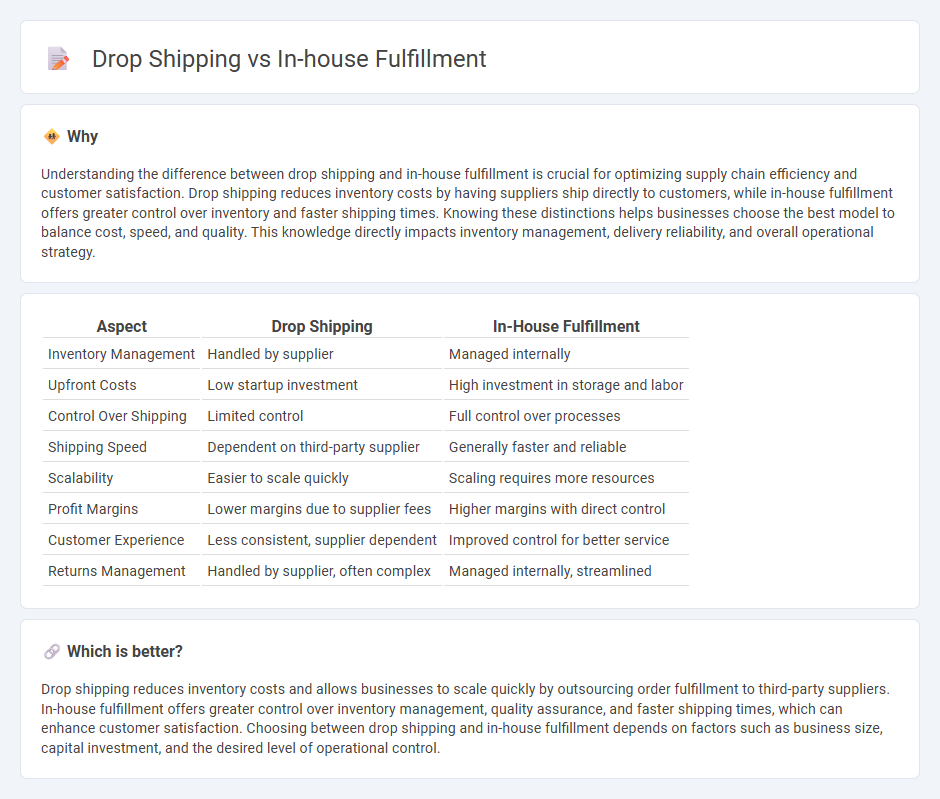
Drop shipping involves outsourcing order fulfillment to third-party suppliers who ship products directly to customers, minimizing inventory costs and upfront investment. In-house fulfillment requires managing storage, packaging, and shipping internally, offering greater control over inventory and customer experience but increasing operational complexity and expenses. Explore detailed comparisons to determine which logistics strategy best suits your business model and growth goals.
Why it is important
Understanding the difference between drop shipping and in-house fulfillment is crucial for optimizing supply chain efficiency and customer satisfaction. Drop shipping reduces inventory costs by having suppliers ship directly to customers, while in-house fulfillment offers greater control over inventory and faster shipping times. Knowing these distinctions helps businesses choose the best model to balance cost, speed, and quality. This knowledge directly impacts inventory management, delivery reliability, and overall operational strategy.
Comparison Table
| Aspect | Drop Shipping | In-House Fulfillment |
|---|---|---|
| Inventory Management | Handled by supplier | Managed internally |
| Upfront Costs | Low startup investment | High investment in storage and labor |
| Control Over Shipping | Limited control | Full control over processes |
| Shipping Speed | Dependent on third-party supplier | Generally faster and reliable |
| Scalability | Easier to scale quickly | Scaling requires more resources |
| Profit Margins | Lower margins due to supplier fees | Higher margins with direct control |
| Customer Experience | Less consistent, supplier dependent | Improved control for better service |
| Returns Management | Handled by supplier, often complex | Managed internally, streamlined |
Which is better?
Drop shipping reduces inventory costs and allows businesses to scale quickly by outsourcing order fulfillment to third-party suppliers. In-house fulfillment offers greater control over inventory management, quality assurance, and faster shipping times, which can enhance customer satisfaction. Choosing between drop shipping and in-house fulfillment depends on factors such as business size, capital investment, and the desired level of operational control.
Connection
Drop shipping and in-house fulfillment are connected through their roles in supply chain management and order processing. Both methods aim to efficiently deliver products to customers but differ in inventory handling, where drop shipping transfers shipping responsibility to third-party suppliers and in-house fulfillment manages inventory internally. Integrating these models allows businesses to optimize logistics flexibility, reduce overhead costs, and enhance customer service levels.
Key Terms
Inventory Management
In-house fulfillment provides complete control over inventory management, enabling real-time tracking, quality assurance, and direct handling of stock to reduce errors and delays. Drop shipping eliminates the need to hold inventory, relying on suppliers to manage stock levels and shipment, which can result in less oversight and potential stockouts. Explore detailed comparisons to understand which inventory method best suits your business needs.
Order Processing
In-house fulfillment offers direct control over order processing, enabling customized packaging and faster handling times with immediate inventory access. Drop shipping relies on third-party suppliers for order processing, which can lead to longer shipping times and less oversight on packaging quality. Discover the detailed impacts of each method on your business efficiency and customer satisfaction.
Shipping Responsibility
In-house fulfillment places shipping responsibility directly with the retailer, requiring management of inventory, packaging, and carrier coordination to ensure timely delivery. Drop shipping shifts shipping duties to the supplier, allowing retailers to minimize handling but potentially sacrificing control over shipping speed and quality. Explore the advantages and challenges of each method to determine the best fit for your business logistics.
Source and External Links
3PL vs In-House Fulfillment - Choosing the Right Fulfillment Method - In-house fulfillment means that a company manages its own order fulfillment internally, allowing for greater control, quicker response to changes, enhanced brand image, and deeper integration with operations, but requires more investment in infrastructure and resources.
In-House Fulfillment and Ecommerce - An Ordoro Guide - In-house fulfillment involves purchasing products, storing inventory, making sales, and personally picking, packing, and shipping products, offering businesses full quality control and direct oversight of every order.
Is In-House Order Fulfillment Right for Your Business? (2025) - Shopify - Implementing in-house fulfillment entails setting up a dedicated storage space, acquiring necessary equipment, creating a fulfillment strategy, designing workflows, building a team, and managing shipping to streamline operations and optimize order processing.
 dowidth.com
dowidth.com